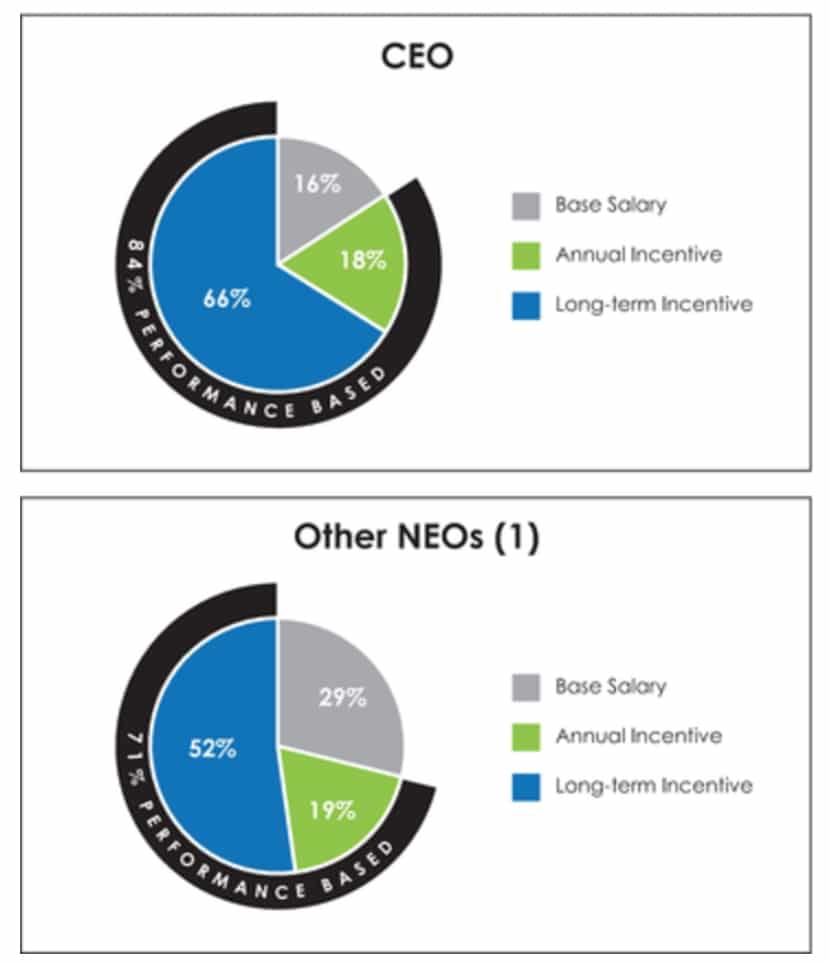Pollution Payday: Analysis of executive compensation and incentives of the largest U.S. investor-owned utilities
CMS Energy (Consumers Energy)
CMS Energy is the holding company for Consumers Energy, Michigan’s largest electric and gas utility serving 6.7 million residents. The holding company also controls two other subsidiaries, CMS Enterprises Company, which operates independent power generation facilities, and EnerBank, a consumer lending company focused on home improvement projects. CMS Energy’s proxy statement describes its executive compensation policy as “balanced and simple.” It consists of a base salary, an annual incentive program, and a long-term incentive formula to reward executives with restricted stock.

Executives’ base salaries are adjusted to reflect the median of a peer group made up of companies of a similar business profile and size – it is composed of 19 utilities, such as DTE Energy, WEC Energy, and Xcel Energy. CMS says that it reviews executives’ salaries annually and may adjust them based on a variety of factors, including overall performance and tenure. In 2019, CMS CEO Patricia Pope earned $1,250,000 in base salary.
The annual incentive program is a performance-based cash compensation program that is only awarded if executives meet or exceed a set earnings per share (EPS) goal or the operating cash flow (OCF) goal, which the Board’s Compensation Committee approves in January of each year. The Board places greater emphasis on the annual EPS incentive to “reflect the Corporation’s and shareholders’ focus on EPS growth.” In 2019, EPS comprised a 70% weighted average of the annual incentive program, compared to 30% for the OCF metric. Additionally, the company has established, on the basis of performance, a 15% threshold to 200% maximum target incentive range. In 2019, CMS Energy’s EPS was $2.49, which exceeded the target of $2.47, resulting in a 127% payout for this metric. The company’s OCF was $1.72 billion, which exceeded the target of $1.7 billion, resulting in a 110% payout for this metric.
CMS also increases its annual incentive program by 10% if the company achieves various operating goals, such as keeping customer outage minutes to a minimum, reducing phishing click rates, completing orders within a targeted time frame, and preventing work-related fatalities. The Board believes it is important to link financial performance goals to “performance goals related to safety, reliability and customer value.”
A substantial portion of named executive officer (NEO) compensation derives from long-term incentives. The long-term incentive is based on total shareholder return (TSR) (capital gains and dividends) and EPS growth. The payout formula consists of performance-based restricted stock and tenure-based restricted stock. Between 2017 and 2019, TSR growth over the three-year performance measurement period was 61%, while the median TSR of CMS Energy’s peer group was 44%, which resulted in CMS executives achieving a stock vesting level of 155%. At the time of the 2020 proxy filing, it was not known if CMS Energy executives achieved EPS growth over the three-year performance period relative to their peer group.
Unlike other companies, CMS Energy has “no excessive perquisites. No planes, cars, clubs, security or financial planning. The principal perquisite provided to our executives in 2019 was an annual mandatory physical examination for each NEO.” The Board’s Compensation Committee requires the physical examination because “it is an effective method of protecting the NEOs and us from preventable health-related disruptions.”
CMS Energy has no incentive policies relevant to decarbonization, despite the fact that the utility has committed to achieving net-zero carbon emissions by 2040 and net-zero methane emissions from its gas delivery system by 2030, and highlighted in its proxy materials that 2019 was a “successful year of world class performance delivering hometown service with achievements in our triple bottom line of people, planet and profit.”
| CEO compensation ranking among utilities studied, 2019 | 18/19 |
| Compensation ratio: CEO to median employee, 2019 | 73:1 |
| Percent change in CEO compensation, 2017-2019 | +31.0% ($2,124,407) |
| Maximum payout of performance-based shares as a percentage of target, 2019 | 200% |
| Is CMS’ executive compensation structure aligned with decarbonization? | No. CMS does not incentivize carbon reductions, despite the utility’s 2040 net-zero carbon emissions goal. |
| Is there evidence from SEC filings that CMS is using misleading financial metrics to determine executive compensation? | No. |
| What key perquisites or benefits do CMS executives receive? | CMS limits perquisites to an annual mandatory physical examination. It also offers executives a non-qualified supplemental retirement plan. |

